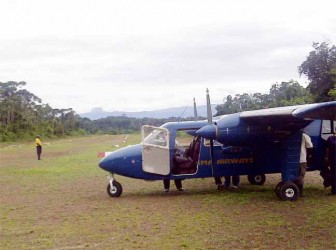Official neglect of interior airstrips, many of which serve strategically important hinterland townships or are, in various ways, critical to Guyana’s economic growth, social progress and territorial security, has become a serious but little talked-about national issue.
While the privately operated aviation sector continues to provide the Guyana Civil Aviation Authority (GCAA) with assessments of the state of interior airstrips and the costs associated with rendering them usable,

funds for work on the airstrips are not being made available. “In some cases it will not take a lot to bring many of these runways up to standard,” former director of Civil Avia-tion Anthony Mekdeci told Stabroek Business.
With much of Guyana’s hinterland not easily accessible except by air, interior airstrips have become central to what has become the daily movement of passengers and cargo from Ogle to the various interior communities. These days, it is mining activity that is responsible for much of the air traffic between the coast and the interior. The forestry and tourism sectors also rely on the efficient operation of the country’s domestic aviation infrastructure. Accelerated hinterland economic activity has also witnessed the growth of several interior communities. Travel to and from interior communities for routine business purposes and to secure access to better medical attention than is available at interior locations are other reasons why Guyana needs reliable interior airstrips. To say that many of them have been neglected for years is a profound understatement. Many of them are sufficiently badly in need of restoration and rehabilitation that expert opinion has deemed them safety threats.
At least 19 of the country’s airstrips have been expertly evaluated as safety threats, many of them serving mining locations where the current ‘gold rush’ means that even in their run-down state they continue to endure frequent passenger and cargo flights.
Airstrips at Bartica, Mabaruma, Matthew’s Ridge, Port Kaituma, Im-baimadai and Kurupung, all of which serve key mining communities are among those in various stages of disrepair while airstrips serving Kaieteur and Iwok-rama, two of the more important locations for tour-ism and environmental pursuits are also in need of repair and rehabilitation, At Lethem too, a strategically important and thriving border community rendered more important in recent years on account of its role in cementing trading ties with neighbouring Brazil, the airstrip is in need of resurfacing.
Concern over the state of interior airstrips grows as the Ogle International Air-port Project approaches completion. The prospect of flights directly from the Caribbean to Ogle next year with local connections directly to hinterland tourist and business locations attaches a sense of urgency to the rehabilitation of the airstrips. Director of the GCAA Zulficar Mohammed told Stabroek Business that the authority was responsible for reporting runway defects and other issues affecting the smooth functioning of airstrips to the Ministry of Public Works which has direct responsibility for airstrips. He said the authority would advise the relevant official in the Public Works Ministry of airstrip defects based on reports received from pilots and aircraft owners. “We obtain reports and pass these on,” Mohamed told Stabroek Business.
Over time, it is the Guyana Aircraft Owners Association (GAOA) that is displaying a sense of urgency over defective interior airstrips, assessing their condition and passing reports on to the GCAA. The reason is understandable. It is private aircraft that take a pounding from landings and takeoffs from the airstrips and private aviation companies must ensure the safety of their pilots, passengers and aircraft.
Mekdeci, who is the serving Chief Executive Officer of the Ogle Airport Authority, the private consortium currently modernizing and expanding the existing aviation facilities at Ogle, anticipates that with the full and final completion of the facility by year end, possible tourist and business connections to the interior from flights originating in the Caribbean and landing at Ogle make the renovation and repairs to interior airstrips a priority.
Stabroek Business has learnt that the defective interior airstrips are in need of various types of attention ranging from the clearing of brush and shrub in the vicinity of the airstrips to complete runway resurfacing. The costs associated with the completion of these works range from $200,000 in cases where runway approaches require clearing of brush and shrub to several millions of dollars in cases where runways require complete resurfacing.
Among the airstrips which local aviation experts say require complete resurfacing are those at Imbai-madai, Baramita, Kurupung, Lethem, and Bemichi. Lesser repairs or maintenance are required at air-strips at Kaieteur, Iwok-rama, Annai, Bartica, Maba-ruma and Port Kaituma. Airstrips in other mining and farming communities in the interior including Kurupung and Matthew’s Ridge are also in need of maintenance and rehabilitation.
Assistant Aviation Inspector in the Ministry of Public Works Alphonso Mangah confirmed the some of the interior airstrips have issues that need to be addressed. He explained that the ministry has an arrangement with residents living close to interior airstrips that allow for basic maintenance including the patching of potholes and the clearing of bush and shrubs. He conceded, however, that other airstrips are in need of more involved rehabilitative attention, but said there was a programme in place to undertake such works. Mangah said he was aware that major rehabilitation work was being undertaken at the Kamarang airstrip at this time. He added, however, that the continuity of such works was dependent on the availability of a budget and that as far as he was aware funds are yet to be made available for this year. Mangah also told Stabroek Business that he was aware that some of the deficiencies cited at interior airstrips were longstanding and that some had been categorized as safety threats.
Mekdeci, meanwhile, has told Stabroek Business that rehabilitating and in some cases increasing the size of airstrips could encourage local aircraft owners to invest in larger carriers that would result in cheaper flights to interior destinations. “Better runways will obviously benefit the travelling public. You are likely to get larger aircraft; econo-mies of scale and cheaper fares,” he added.





